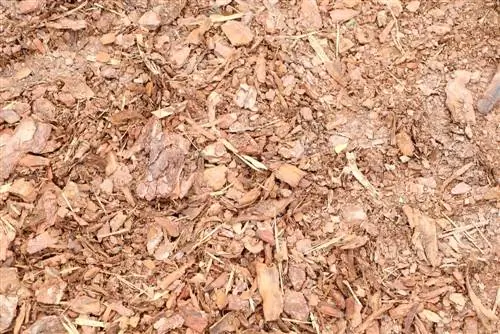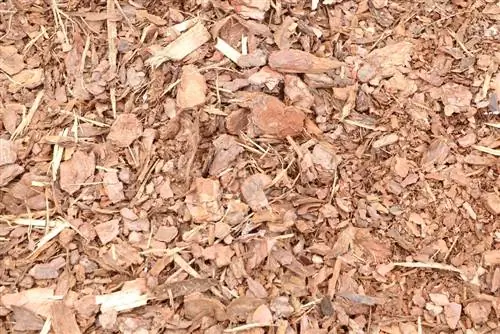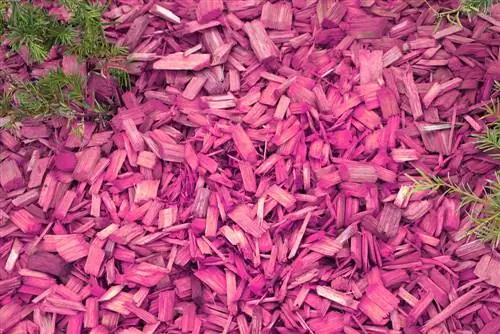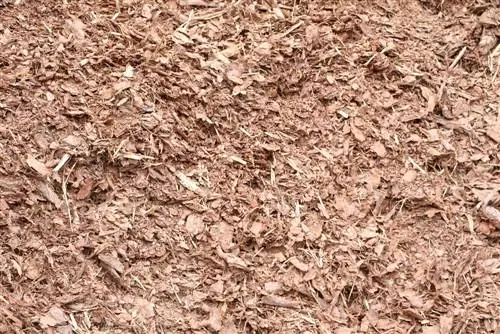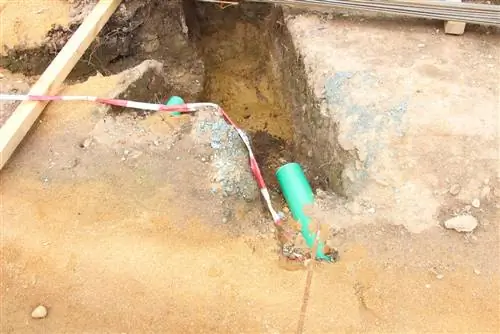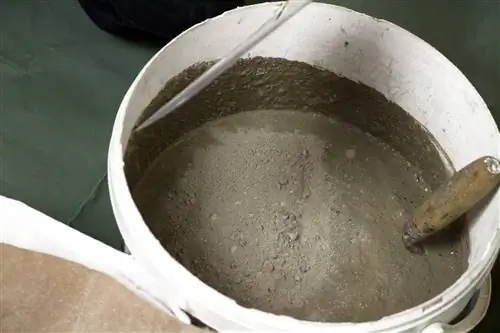- Author admin [email protected].
- Public 2023-12-17 03:39.
- Last modified 2025-06-01 06:48.
Bark mulch at a bargain price sometimes doesn't even begin to deserve the name. The legislator does not provide a precise definition of the composition, which leads to significant differences in the quality of the offering. The price should therefore not be the sole criterion for purchase. This guide will inform you about the connection between quality characteristics and prices of bark mulch, including the cost per cubic meter. Budget hunters among home gardeners benefit from our tips for free alternatives.
Cost per cubic meter
Bark mulch is available in different grain sizes and colors. Basic products usually come from local conifers such as spruce and pine. The bark of pine, oak or other valuable tree species is used in high-quality products. The costs per cubic meter are therefore closely related to the product variant chosen. The following list provides a general overview of the cost structure:
- Classic bark mulch, brown,fine grain 0 to 20 mm: from 107, 50 euros per m³
- Classic bark mulch, brown,medium grain size 0 to 40 mm: from 69, 80 euros per m³
- Bark mulch withNitrogen addition, brown, medium grain size 0 to 40 mm: from 90.00 euros per m³
- Pine mulch, brown-natural, coarse grain size 60 to 120 mm: from 150.00 euros per m³
- Bark mulchwithout tannic acid, red-brown, coarse grain size 0 to 40 mm: from 64.00 euros per m³
- Rose mulch, brown, fine grain size 0 to 20 mm: from 188, 60 euros per m³
- Pine bark mulch, dark red to reddish brown, medium-fine grain size 15 to 30 mm: from 240.00 euros per m³
- Decorative mulch, nut brown, stone gray, golden yellow or brick red, grain size 10 to 40 mm: from 339, 20 euros per m³
The prices mentioned refer to bark mulch from specialist retailers that is available all year round. Promotional offers from discounters can be significantly lower, but are only available for a few days to a maximum of one or two weeks.
Tip:
Bark mulch only develops its effect as a natural source of humus over the years. In the first stage of decomposition, mulch primarily removes nitrogen from the soil. The distribution of fresh bark mulch in the garden therefore goes hand in hand with the administration of a nitrogen-rich fertilizer, such as horn shavings or nettle manure.
Identifying differences in quality - this is how it works
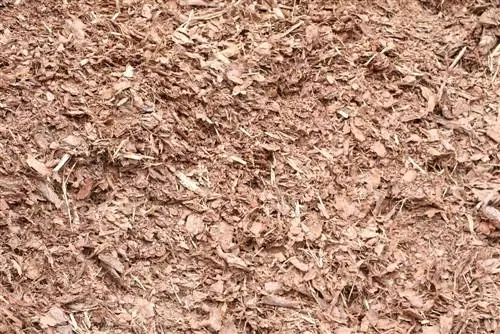
With the above overview of bark mulch prices, this guide would be an informative conclusion if the legislature had not yet failed to set clear quality criteria. In fact, there is no specification as to what bark mulch should be made of. Strictly speaking, the product does not even have to contain tree bark, but can contain 100 percent foreign substances as long as they are of plant origin. The costs per cubic meter are therefore only an indication for purchasing bark mulch. For your orientation, we have compiled important positive characteristics as distinguishing criteria below:
Even grain
High-quality bark mulch consists of uniformly sized pieces of bark with a grain size of 16 to 25 mm. Smaller pieces decompose too quickly, meaning effective suppression of weeds is only guaranteed for a short time. Manufacturers of cheap products forego sorting for cost reasons. In this case, the bags contain a mixture of fine material and thick chunks. This creates an uneven appearance and quickly leads to gaps in the mulch carpet, where small-grain bark mulch decomposes prematurely.
Minimal proportion of foreign substances
Bark mulch should in principle consist exclusively of tree bark. A small proportion of green compost or wood chips hardly affects the quality. Since there are of course no limits for the proportion of foreign substances, some manufacturers exploit this gap to the limit of what is tolerable. Unwanted components such as branches, stones, plastic parts and even broken glass have been found in discounter offers. It does not follow that inexpensive bark mulch has to be of poor quality. The RAL quality mark ensures buyer security when purchasing bark mulch. The manufacturers of the “Quality Association for Substrates for Plants” are committed to complying with fundamental requirements, such as a low proportion of foreign substances, uniform grain size and maximum hygiene.
Freshness
You can sniff out the third quality feature. High-quality bark mulch exudes a pleasant scent of fresh forest soil. A musty smell, on the other hand, reveals a product of inferior quality with a high proportion of moist soil, which is often already moldy.
Tip:
All efforts to acquire bark mulch with the ideal price/performance ratio will be in vain if the material is applied improperly. Bark mulch can only fulfill its function as a weed inhibitor if it is spread in a layer of 5 to 8 cm thick.
Are there free alternatives?
The prices for bark mulch are constantly rising. There is no end in sight to the cost explosion because the problem is closely linked to forest dieback. The costs per cubic meter are already difficult for many home gardeners to bear. Consequently, the focus is on free alternatives to bark mulch. The following options have the potential to replace tree bark as a garden mulching material:
miscanthus chaff
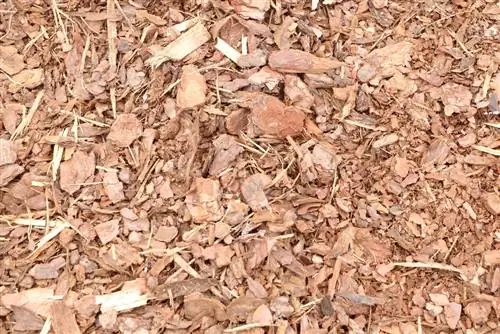
Majestic ornamental grasses are very popular as privacy plants. The multi-faceted varieties of miscanthus (Miscanthus sinensis) are leading the way in private garden design in this respect. The grass care program includes radical pruning to a hand's width above the ground. The clippings provide you with a free alternative to bark mulch. Miscanthus chaff reliably covers the soil, suppresses annoying weeds from a layer height of 5 cm, is pH-neutral and does not smell. The edges of the grasses are still razor-sharp even when shredded, which keeps voracious snails at bay.
Lawn cutting
After every mowing, the collecting basket on the lawn mower is full of free mulching material. Grass clippings are the ideal alternative to bark mulch, especially in vegetable beds. Fresh grass clippings should be allowed to dry for a few days before use to prevent them from becoming moldy. When the grass in the bed later withers completely, it forms a natural protective layer against weeds and keeps the soil warm and slightly moist for longer.
Autumn leaves
A free alternative to bark mulch falls in large quantities from deciduous trees and bushes every year. Autumn leaves are perfect as mulch for all plants whose natural habitat is in the forest or along clearings. The dead leaves decompose over the course of the year and enrich the soil with valuable humus. Before using as mulch, autumn leaves should go through a rotting phase for about 2 weeks. Then distribute the leaf mulch in the bed, under hedges, bushes and trees. The leaves of oak, chestnut or walnut trees have a coarse structure and decompose very slowly. This foliage should therefore be shredded in the shredder before being used as mulch.
Tip:
Mulch made from oak leaves lowers the pH value in the soil. Therefore, use autumn leaves from oak trees primarily as mulch under trees with a preference for acidic soil, such as rhododendrons.
Cuttings after hedge trimming
Fast-growing deciduous hedges rely on regular pruning so that they maintain a well-groomed appearance. The clippings are ideal as a free replacement for bark mulch. Branches that are too large and thicker branches are shredded using a garden shredder.
Weak-consuming ground cover plants
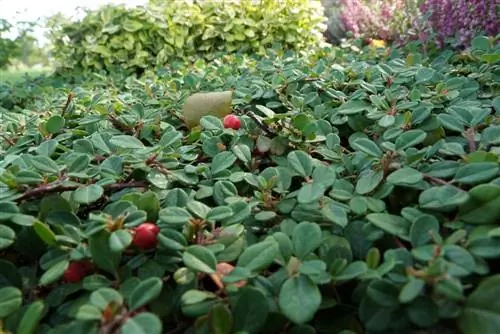
As bark mulch prices rise, the ecologically more sensible method of planting ground cover plants is coming into focus for weed inhibition. The focus is on perennials with low nutrient consumption and creeping, runner-forming growth. Evergreen plant species ensure a well-groomed, weed-free appearance even during the cold season. The natural alternative to bark mulch is available to you free of charge if you harvest and sow the ripe seeds of ground cover plants or collect cuttings for propagation. The following species and varieties fulfill the task brilliantly:
- Storksbill (Geranium) with more than 300 species for almost every soil condition
- Small evergreen (Vinca minor), easy-care ground cover with evergreen foliage and pretty spring flowers
- Carpet phlox (phlox), cushion-like growth with wintergreen, needle-like leaves, blooms in May
The easy-care star moss (Sagina subulata) is almost as sturdy as bark mulch. Thanks to diligent self-sowing, the pretty ground cover makes a free contribution to the uninterrupted suppression of weeds on its own. In contrast, bark mulch needs to be refreshed every 2 to 3 years, which means regularly digging deep into your wallet.

